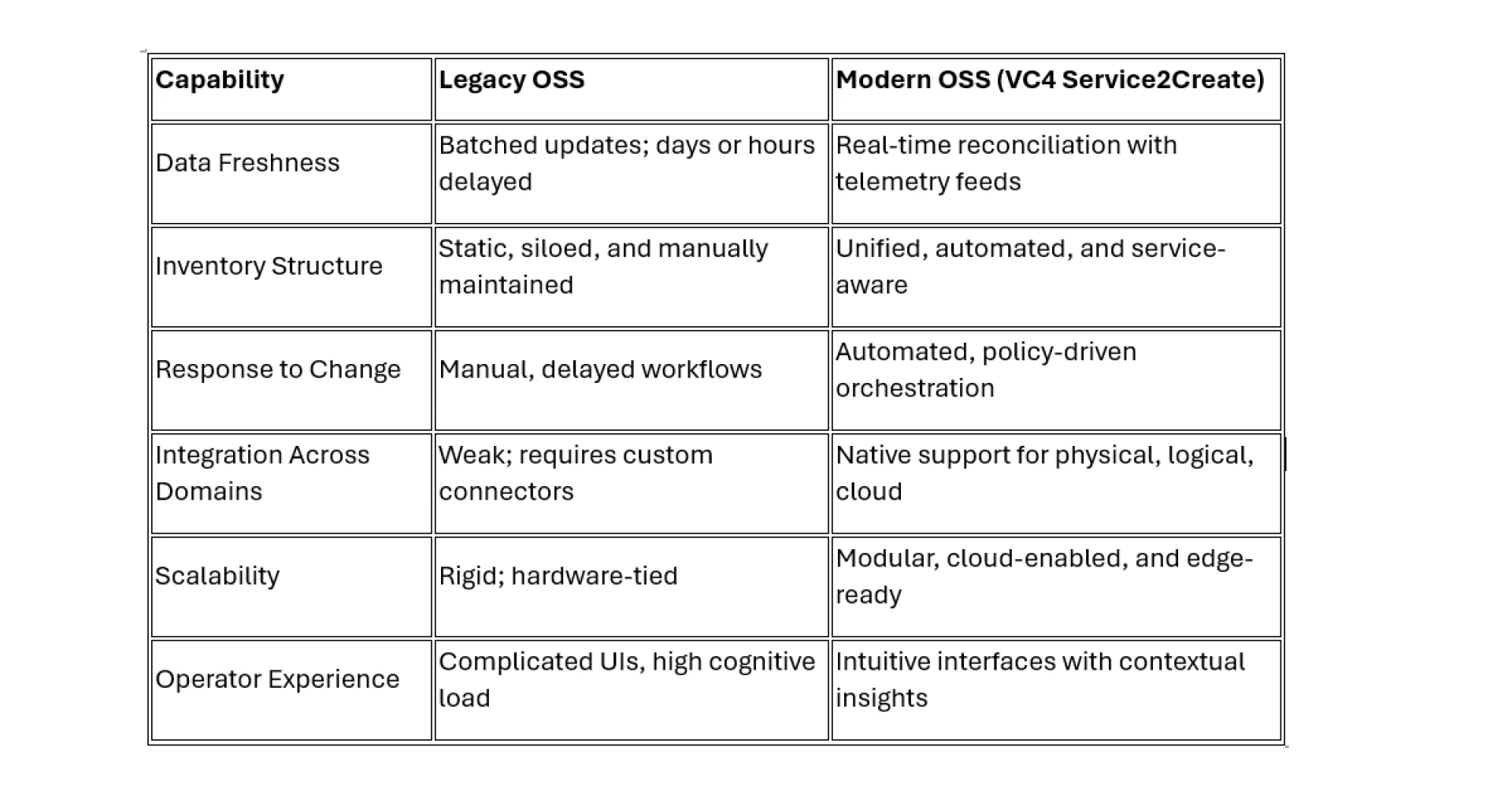Telecom networks are accelerating into a new era—one defined by flexibility, speed, and intelligence. Services that once relied on fixed, hardware-bound infrastructure are now being delivered over programmable control planes, orchestrated through cloud-native platforms, and activated with near-instant provisioning. This evolution is empowering operators to meet customer demands faster, scale services more efficiently, and unlock entirely new revenue models.
Yet amid this momentum, one foundational layer has struggled to keep pace: the Operational Support System (OSS). Traditional OSS platforms, originally designed to document slow-moving changes and maintain rigid order, are now challenged by the dynamic, real-time nature of modern telecom environments. What once served as a source of stability has become a limiting factor—introducing friction, delaying innovation, and obstructing visibility.
But this isn’t a dead end—it’s a turning point. Operators now have the opportunity to reimagine OSS not as a static system of record, but as a real-time, intelligent platform that actively supports change, connects teams, and drives operational excellence. In this blog, we’ll explore why legacy OSS is no longer fit for purpose—and what’s truly required to thrive in the fast-moving world of modern network operations.
The Real Reasons Why Evolved Telecom Is Leaving Legacy OSS Behind
Telecom infrastructure is shifting from deterministic, hardware-bound systems to distributed, software-native environments. What was once governed by static design is now guided by programmable control planes, telemetry-driven automation, and service components that operate across cloud, edge, and hybrid domains.
Operational Support Systems (OSS), originally designed to enforce structure and minimize change, are increasingly misaligned with how networks function. Where networks now adapt in milliseconds, many OSS platforms still operate in cycles measured by batch jobs and manual reconciliation.
This disconnect isn’t about technical debt—it’s about architectural irrelevance. Legacy OSS weren’t built to navigate:
- The real-time volatility of virtualized infrastructure
- The abstracted complexity of service chaining
- The interdependencies that define next-gen service delivery
Why Legacy OSS Systems Fail to Support Modern Telecom Networks
Legacy OSS systems weren’t designed for today. Their architecture was built for a telecom era of static services, rigid topologies, and human-led oversight. They assumed configurations were permanent, that changes were infrequent and easily documented.
But networks have since evolved into dynamic, shape-shifting organisms — merging physical and virtual layers, constantly reconfiguring, and demanding immediate awareness. That foundational mismatch is why older OSS now behave more like blindfolds than instruments.
They simply weren’t made to handle:
- Real-time reconciliation across fragmented inventories
- Coordination between traditional MPLS backbones and ephemeral SD-WAN overlays
- Lifecycle visibility across constantly mutating services
Yet many telecoms still cling to these systems, pouring effort into patches that never quite restore clarity. The cost? Sluggish service rollout, overprovisioned assets, and sprawling blind spots.
How Modern Network Evolution Exposes Legacy OSS Limitations
Telecom networks no longer operate as static environments. Today’s infrastructure is layered, hybrid, and in constant motion. As operators expand their service portfolios and adopt software-defined networking, legacy OSS systems struggle to keep pace with the diversity and velocity of changes.
Here's how this evolution reveals their cracks:
- Multi-textured: Fiber, copper, microwave, 5G, cloud edge, all interleaved
- Cross-contextual: Spanning wholesale, mobile, residential, IoT, and overlay domains
- In flux: Services spin up and vanish based on usage and intent
These shifts demand systems that not only store data but interpret it in real-time. But legacy OSS treats the network like an inventory sheet frozen in time.
This forces engineers to:
- Work with outdated assumptions
- Postpone rollouts due to inventory unknowns
- Build side systems and spreadsheets to survive daily operations
Where Legacy OSS Platforms Fail in Practice
- Tight Coupling to Static Infrastructure: These platforms are hardwired to fixed hierarchies. Trying to “adapt” them introduces fragile workarounds that often create more risk.
- Inability to Ingest and Act on Real-Time Signals: Modern networks generate rich telemetry. Legacy OSS often reduce that insight to lagging reports based on polling intervals.
- Siloed Data and Functional Discontinuity: Provisioning, performance, and fault modules rarely share a unified model, keeping teams out of sync.
- Operator Friction: Dated UIs, rigid workflows, and static dashboards increase NOC workload and slow resolution cycles.
- Maintenance Burden and Vendor Entrapment: High-touch customization and obsolete protocol support lead to rising operational costs and limited extensibility.
The Business Impact of Sticking with Outdated OSS
Clinging to outdated OSS systems has ripple effects across operations and business outcomes. It slows innovation, raises risks, and erodes interdepartmental trust.
The costliest consequences include:
- Customer dissatisfaction: Incorrect records cause failed activations and lingering outages
- Impaired planning: Decisions are based on outdated or incomplete data
- Regulatory exposure: Audit trails are patchy, incomplete, or missing entirely
- Stalled growth: Time spent correcting the past undermines capacity to innovate
Conclusion: Why the Future Starts with OSS Modernization — and S2C
It’s no longer a question of “if” legacy OSS needs to go—but “how soon.” OSS platforms that can’t interpret network behaviour in real-time are operational liabilities. Modern networks demand tools that are responsive, intelligent, and integrated.
That’s where VC4 Service2Create (S2C) comes in.
S2C redefines OSS by offering a unified, real-time view across physical, logical, and spatial assets. With built-in lifecycle governance, automated reconciliation, and impact analysis, it doesn’t just reflect your network—it helps you command it.
Comparison Table: Legacy OSS vs. Modern OSS with VC4 Service2Create

If your current OSS is slowing you down, it's time to move forward. With S2C, modernization becomes measurable, meaningful, and aligned with your growth. If you’re interested to know more about S2C, then feel free to browse the VC4 website or contact their professional sales team with any questions or for a personalized demo.



